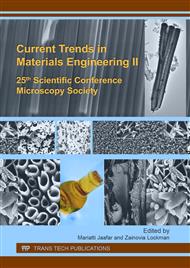p.74
p.79
p.83
p.87
p.91
p.95
p.99
p.103
p.107
The Effect of Heating Rate and Temperature on Mechanical and Microstructure Properties of β-TCP by Microwave Sintering
Abstract:
This aim of this work was to evaluate the influences of the heating rates and sintering temperatures for sintering β-TCP by microwave furnace. In the first part of work, the heating rates used for sintering β-TCP were including 10, 20, 30 and 40°C/min. Results from physical and mechanical analysis shown that the optimum properties were shown by samples produced at heating rate of 30°C/min. In the second part of the study, the heating rate of 30°C/min was continuing used to sintering samples by different temperatures (1200°C, 1250°C and 1300°C). The sintered sample at 1200°C presented the optimum properties in the physical and mechanical analysis. Finally, the sintered samples by the heating rate 30°C/min at 1200°C were in immersed in SBF to confirm the bioactivity property of β-TCP.
Info:
Periodical:
Pages:
91-94
Citation:
Online since:
September 2017
Keywords:
Price:
Сopyright:
© 2017 Trans Tech Publications Ltd. All Rights Reserved
Share:
Citation:


